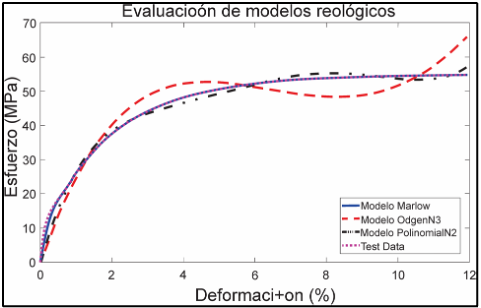Numerical analysis of contact between chain with plastic elements and metal catarine using hyperelastic models
DOI:
https://doi.org/10.37636/recit.v5n1e149Keywords:
Finite element, Hyperelastic models, plastic chainAbstract
In this work a numerical analysis of the coupling between a motor sprocket and a chain with plastic elements in the power transmission is presented. The study is carried out through numerical analysis with finite element software. The system considers the rheological models for the characterization of the plastic material of the chain. Based on the present study, the usefulness of the Marlow model for cases of chains with plastic elements was confirmed. The results show the areas of greatest stress concentration due to the contact between elements for the transmission of power and define the variation of the contact force as a function of the rotation of the sprocket.
Downloads
References
R. A. Calero and J. A. Carta, "Mecanismos de cadenas," in Fundamentos de mecanismos y máquinas para ingenieros, McGraw-Hill, Ed. 1998, pp. 269-287.
American Chain Association, "Chains for Power Transmission and Material Handling," in Standard Handbook of Chains, Second Edi., Tsubakimoto Chain Co., Ed. 2006, pp. 267-280.
TSUBAKI POWER TRANSMISSION [online], 2020, disponible, https://chains.ustsubaki.com/viewitems/anti-corrosive-heat-resistant-chains/poly-steel-chains-2
R. C. Binder, Mechanics of the roller chain drive. Prentice-Hall, 1956.
K. M. Marshek, "On the analyses of sprocket load distribution," Mech. Mach. Theory, vol. 14, no. 2, pp. 135-139, 1979. https://doi.org/10.1016/0094-114X(79)90028-4 DOI: https://doi.org/10.1016/0094-114X(79)90028-4
M. R. Naji and K. M. Marshek, "Analysis of sprocket load distribution," Mech. Mach. Theory, vol. 18, no. 5, pp. 349-356, 1983. https://doi.org/10.1016/0094-114X(83)90130-1 DOI: https://doi.org/10.1016/0094-114X(83)90130-1
M. R. Naji and K. M. Marshek, The effects of the pitch difference on the load distribution of a roller chain drive, vol. 24, no. 5. 1989. https://doi.org/10.1016/0094-114X(89)90065-7 DOI: https://doi.org/10.1016/0094-114X(89)90065-7
I. Troedsson and L. Vedmar, "A method to determine the dynamic load distribution in a chain drive," J. Mech. Eng. Sci., vol. 215, pp. 569-579, 2001. https://doi.org/10.1243/0954406011520959 DOI: https://doi.org/10.1243/0954406011520959
B. H. Eldiwany and K. M. Marshek, "Experimental load distributions for double pitch steel roller chains on polymer sprockets," Mech. Mach. Theory, vol. 24, no. 5, pp. 335-349, 1989. https://doi.org/10.1016/0094-114X(89)90064-5 DOI: https://doi.org/10.1016/0094-114X(89)90064-5
U. S. Tsubaki, The Complete Guide to Chain. Wheeling, Illinois: Sachio Shimura, 1997.
T. C. Co, "Tsubaki drive chains & sprockets." .
K. L. Johnson, "Contact mechanics," C. U. Press, Ed. 1985, pp. 84-104. https://doi.org/10.1017/CBO9781139171731 DOI: https://doi.org/10.1017/CBO9781139171731
M. E. Ródenas, E. Universitaria, and D. E. Empresariales, "Análisis por elementos finitos: una metodología muy reciente en n economía," pp. 1-11.
B. Trobentar and S. Glodež, "Deflection Analysis of Spur Polymer Gear Teeth," J. Multidiscip. Eng. Sci. Technol., vol. 2, no. 4, pp. 847-853, 2015.
B. Trobentar, S. Glodež, and B. Zafošnik, "Deflection Analysis of Spur Polymer Gear Teeth," J. Multidiscip. Eng. Sci. Technol., vol. 2, no. 4, pp. 847-853, 2015.
G. Liu and S. Quek, The Finite Element Method: A Practical Course. Butterworth-Heinemann, 2003.
R. Tobajas, D. Elduque, C. Javierre, E. Ibarz, and L. Gracia, "A comparative study of hiperelastic constitutive models or an automotive component material," no. c, pp. 338-347, 2016.
A. E. Ehret, "On a molecular statistical basis for Ogden ' s model of rubber elasticity," J. Mech. Phys. Solids, 2015. DOI: https://doi.org/10.1016/j.jmps.2015.02.006
https://doi.org/10.1016/j.jmps.2015.02.006 DOI: https://doi.org/10.1016/j.jmps.2015.02.006
M. A. Domínguez, "Estudio numérico de la influencia de la rigidez de contacto de los elementos de transmisión de potencia en una cadena en caso de impacto," Tesis de maestría, Centro Nacional de Investigación y Desarrollo Tecnológico, 2018.
Dupont, "Product information: DuPontTM Engineering Polymers Delrin Delrin ® 100 NC010." pp. 1-9, 2014.
U. S. Tsubaki, "The Complete Guide to Chain," Tsubaki., M. Kanehira, Ed. 1997, pp. 85-115.
S. Anders, "Polycarbonates polyacetals polyesters cellulose esters," Hanser Ver. 1996.
Tsubaki, TheComplete Guide to Chain. Illinois: Sachio Shimura, 1997.
Trobentar, B. and S ". Glodež, 2015, Deflection analysis of spur polymer gear teeth",͟ Journal of Multidisciplinary Engineering Science and Technology, vol. 2, no. 4, pp. 847-853.
T. Bhoite, P. Pawar, and B. Gaikwad, "FEA based study of effect of radial variation of outer link in a typical roller chain link assembly," Int. J. Mech. Ind. Eng., vol. 1, pp. 65-70, 2012. DOI: https://doi.org/10.47893/IJMIE.2012.1070
https://doi.org/10.47893/IJMIE.2012.1070 DOI: https://doi.org/10.47893/IJMIE.2012.1070
ASTM D638-02a "Standard Test Method for Tensile Properties of Plastics"

Published
How to Cite
Issue
Section
Categories
License
Copyright (c) 2022 Miguel Alberto Domínguez Gurría, Dariusz Szwedowicz, Ulises Augusto Jaén Rendon, Eladio Martínez Rayón, Ángelo Garibaldi Rodríguez

This work is licensed under a Creative Commons Attribution 4.0 International License.
The authors who publish in this journal accept the following conditions:
The authors retain the copyright and assign to the journal the right of the first publication, with the work registered with the Creative Commons Attribution license 4.0, which allows third parties to use what is published as long as they mention the authorship of the work and the first publication in this magazine.
Authors may make other independent and additional contractual agreements for the non-exclusive distribution of the version of the article published in this journal (eg, include it in an institutional repository or publish it in a book) as long as they clearly indicate that the work it was first published in this magazine.
Authors are allowed and encouraged to share their work online (for example: in institutional repositories or personal web pages) before and during the manuscript submission process, as it can lead to productive exchanges, greater and more quick citation of published work (see The Effect of Open Access).











